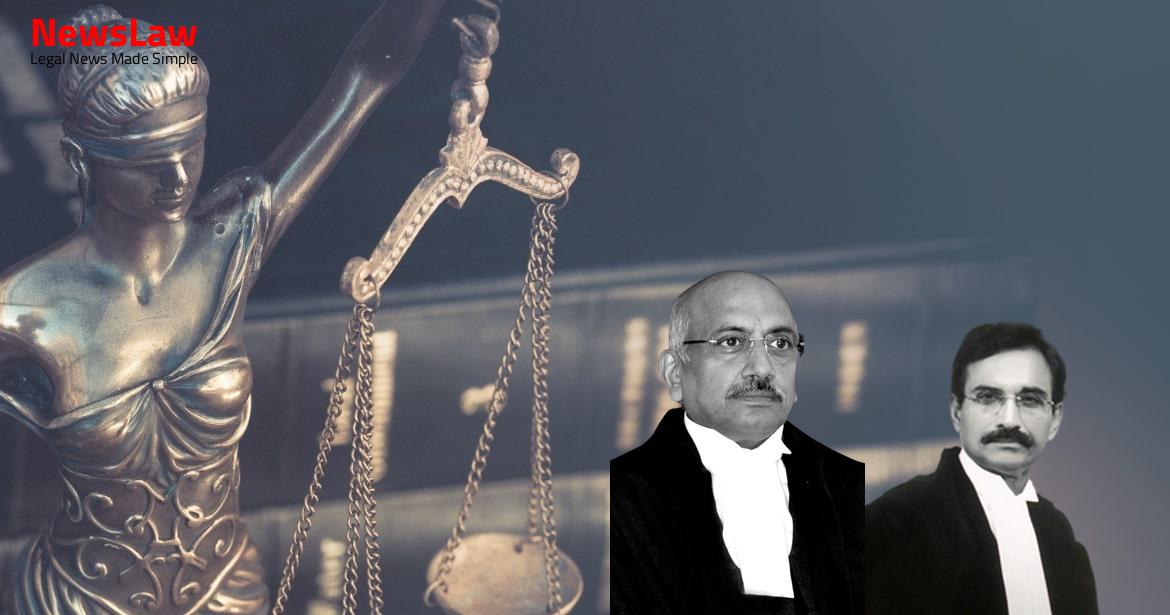In a significant legal development, the Supreme Court has issued a ruling regarding a dispute over the declaration of land for a Slum Rehabilitation Area. The case involved various parties and complex legal arguments, ultimately leading to a decision that impacts the future of the area in question. This ruling sets a precedent for similar cases and provides clarity on the interpretation of relevant laws and regulations.
Facts
- On 24.05.2006, a declaration was made by Respondent No.1 for 5168.50 sq. mts. in Survey Nos. 27 and 28 (Part) at Wadgaon Sheri (Ramwadi), Pune as a slum rehabilitation area.
- Following the declaration, an order was passed by Respondent No.2 on 01.09.2009 declaring the same area as a Slum Clearance Area under Section 3D of the Act.
- The High Court upheld the declarations for the entire 5168.50 sq. mts. area, except for 1045.50 sq. mts. of it.
- The Appellants challenged the High Court’s decision by filing Appeal Nos. 24 and 25 of 2014.
- An Application for Amendment was allowed by the Small Causes Court on 06.02.2006, leading to the declaration of the area as a Slum Rehabilitation Area.
- Respondent No.3 initiated legal action seeking eviction of Appellant No.1’s husband under RCS No.365 of 2000, disputing the area’s classification as a slum.
- The Tribunal partially allowed the Appeals and set aside the Orders dated 24.05.2006 and 01.09.2009 to the extent of 1045.50 sq. mts. of land.
- The Appellants were found to be occupants of tenements in the disputed area and considered as persons aggrieved under Section 3C(2) of the Act.
- The High Court ruled that the Slum Rehabilitation Authority was exercising legislative functions under Sections 3A to 3D of the Act.
- The Tribunal’s decision to set aside the Orders dated 24.05.2006 and 01.09.2009 based on 1045.50 sq. mts. not being a declared area was overturned by the High Court.
- The High Court disagreed with the Appellants’ interpretation of the scope of Section 12 and Section 36 of the Act.
- High Court clarified that a declaration of an area as a slum area under Section 4(1) of the Act is not mandatory before initiating proceedings under Chapter I-A.
- The High Court allowed both Writ Petitions and reversed the Tribunal’s order after a detailed examination of the Act and case facts.
- In the High Court’s view, the Appellants were entitled to a hearing, and pre-decisional hearing before SRA’s declaration under Section 3C was deemed unnecessary.
Also Read: Case of Technical Equipment Officer Appointment Criteria Dispute
Arguments
- Appellant argued that the Tribunal erred in holding Appellants were entitled to notice before the order under Section 3C was passed.
- Appellant contended that the orders under Section 3C and 3D are unsustainable.
- Appellant stated that a notification under Section 4 of the Act is necessary for steps under Chapter I-A, which is missing for 1045.50 sq. mts.
- Appellant argued that the High Court’s reliance on judgments of the High Court of Bombay relating to Development Control Regulations was erroneous.
- Senior Counsel for Respondent argued that the High Court’s judgment is in accordance with the Act and correctly interpreted Chapter I-A, Sections 4, 12, and 36.
- Senior Counsel for Respondent relied on Special Rules and Regulations for Slum Rehabilitation Scheme to argue that encumbered lands can be part of the Slum Rehabilitation Area.
- Senior Counsel for Appellants stated that the Act applies only to slum areas.
- All slum dwellers except the Appellants have shifted to transit accommodation.
- The Scheme has been held up by the Appellants who belong to three families.
- Even the Appellants will be entitled to ownership flats after the development is completed.
- The judgement of the High Court is in the interest of other slum dwellers occupying tenements in the Slum Rehabilitation Area.
Also Read: Supreme Court Judgement on Transfer of Mining Environmental Clearances
Analysis
- The order dated 24.05.2006 under Section 3C of the Act was held to be vitiated by the Tribunal due to non-compliance of Section 36 of the Act.
- No action can be initiated under Section 3D of the Act without a declaration of a slum area under Section 4(1).
- The main contention is that 1045.50 sq. mts. of land was not declared as a slum area under Section 4, which is essential for proceedings under Chapter I-A.
- The Slum Rehabilitation Order under Section 3C must be published in the official gazette and given wide publicity.
- An appeal can be made to the Special Tribunal against the Slum Rehabilitation Order under Section 3C(2).
- No requirement of issuance of notice prior to the declaration under Section 3C.
- A list of eligible slum dwellers was published, where the Appellants’ names were found.
- The Slum Clearance Order is passed under Section 3D after an area is declared as a Slum Rehabilitation Area under Section 3C.
- Chapter I-A is a self-contained code dealing with Slum Rehabilitation Schemes.
- Amendments were made to Chapter I-A by Act 38 of 2018, making it unnecessary for an area to be notified under Section 4 as a slum area before initiating proceedings under Chapter I-A.
- Section 4(1) of the Act allows the Competent Authority to declare an area as a slum area if it poses a danger to public health, safety, or convenience due to inadequate amenities, being insanitary, overcrowded, or unfit for habitation.
- The Competent Authority can also declare buildings in an area as unfit for human habitation if they are dilapidated, overcrowded, poorly designed, lack basic facilities, ventilation, or light, thereby affecting the health, safety, or convenience of the public.
- The declaration of a slum area must be published in the Official Gazette and through other prescribed means to ensure public awareness.
- Section 12 empowers the Competent Authority to issue a clearance order for a declared slum area, mandating the demolition of specified buildings and requiring them to be vacated within a specified period.
- The Slum Rehabilitation Authority has the responsibility to assess existing slum areas, develop rehabilitation schemes, ensure implementation of Slum Rehabilitation Schemes, and undertake any necessary actions for slum rehabilitation.
- The Chief Executive Officer can issue a clearance order for a declared slum rehabilitation area, ordering the demolition of specified buildings and requiring them to be vacated within a specified time frame.
- Service of notice, orders, or directions under the Act can be done by various means like affixing in public places, publishing in local newspapers, sending by registered post, or serving it to a responsible adult if the intended recipient cannot be found.
Also Read: House Breaking by Night: Verdict Reversal and Reinstatement of Military Personnel
Decision
- The Appeals are dismissed accordingly.
- The declaration of 1045.50 sq. mts. under Section 3C of the Act is not a colorable exercise of power.
Case Title: KANTABAI VASANT AHIR Vs. SLUM REHABILITATION AUTHORITY
Case Number: C.A. No.-007784-007787 / 2019



